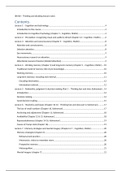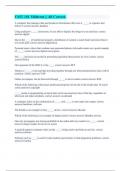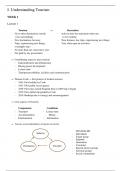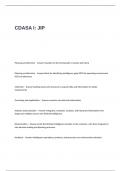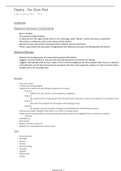Chapter 22- growing economies
GDP: measure of economic activity
Developed economies
- High income levels
- High literacy rates
- High life expectancy
- Good infrastructure
- Highly industrialised (rely more on tertiary sector)
- Low levels of unemployment
Developing economies
- Low income levels
- Low literacy rates
- Low life expectancy
- Poor infrastructure
- Reliance on primary sector
- High unemployment
- High population growth (no contraception)
Emerging economies
- Rapid economic growth, measured in GDP
- Investors like this market as it grows more quickly than mature markets
- Business should be able to increase profits and dividends
- Suitable location for international operations (production or sell into domestic
market)
- BRIC and MINT countries
- Increase in avg income means increase in middle class; spending more on both
imported and exported goods and services
- Domestic businesses based in emerging economies expanding into developed
economies
Implications of economic growth for individuals and businesses
Consumers in emerging economies buy more goods and services from domestic
businesses and those in developed economies, making emerging economies look more
attractive.
Trade opportunities
As an economy grows, consumption may also be growing as with growth comes rising
disposable income. Individuals have more money to spend, increasing overall demand
,for goods and services. Demand is likely to become income inelastic. These goods can
be produced domestically or imported from abroad.
Individuals will benefit from increased international trade as they may be able to buy
cheaper goods from overseas where production costs are lower. Greater choice
resulting from growing international trade helps increase standard of living for people.
Employment opportunities
Employment rates are one of the most important indicators of the health of an
economy therefore, firms would be interested in knowing unemployment rates, trends,
labour costs and productivity.
Unemployment rates:
- Give an idea of the jobs being gained/lost
- Tell us whether enough people have disposable income
- High unemployment indicates its not a good idea to export goods there
- High unemployment means firm can find labour there (build factory and export)
Unemployment rates in emerging economies fall as the economy grows quickly and
people find jobs.
Disadvantages of emerging economies
- Doing business in emerging economies is not straightforward. An increased risk
of intellectual property theft, restrictions on the methods of doing business and
competitive challenges from established domestic businesses are threats that
need to be overcome
Indicators of growth
Gross domestic product per capita: measure of economic activity (no. of goods and
services produced in a year divided by no. of ppl in the country). Governments collect
these figures and they are assessed and adjusted for errors.
Human development index: indicates a country’s skills and its people rather than just
the economic conditions by combining stats on life expectancy, education and income
for a particular country.
- Life expectancy
- Mean years of schooling
- gross national income per capita (GNI)
Chapter 23- International trade and business growth
International trade
- Increases consumer choice
, - Increases competition
- Allows countries to have access to goods not produced domestically
- Access to cheaper goods and services in other countries
Visible trade- trading physical goods
Invisible trade- involves trade in services
Visible balance of trade- difference between total visible exports and imports
Exports and imports
- Exports and imports generate revenue for businesses in different countries
Exports: the easiest and least risky mode of entry into an international market is
through exports, exporting has been made easier due to trade liberalisation. This has
reduced tariffs and quotas that may have otherwise limited overseas sales. Exporting
often involves physical goods but it can also involve services or invisible exports. These
are anything other than manufacturing, agriculture and mining and it is mostly
dominated by developed countries. They include services such as tourism, education,
financial services, etc.
Imports: these are the goods and services that are brought into the country from
another. Many countries try to limit the importation of goods by placing trade barriers
in the way. These barriers involve tariffs (taxes on imports). Trade liberalisation and
monitoring by the WTO has reduced/ limited the use of the level of tariffs that can be
levied. However, non-tariff barriers such as giving subsidies to local firms, putting limits
on the number of imports (quotas) and creating rules about how much of a product
must be made and in what way are harder to manage.
Exporting and importing are not always risk free as if a currency were to appreciate,
that country's exports would become more expensive and therefore the demand for
those exports would fall. Additionally, governments can impose barriers to imports
that limit a firm’s access to the market. There may also be conflicts between agents or
distributors that are difficult to resolve from outside the country.
Implications of increasing specialisation by countries and businesses
Specialisation increases the speed and skill with which a task can be done. This saves
time therefore improving efficiency. As markets become larger, opportunities for
specialisation increases.
Specialisation by countries: Countries can specialise in the production of certain
goods and services. They are likely to specialise if they have developed more efficient
production methods than those of their rivals. They can become more efficient
because they have access to cheaper resources such as labour. If countries around the
GDP: measure of economic activity
Developed economies
- High income levels
- High literacy rates
- High life expectancy
- Good infrastructure
- Highly industrialised (rely more on tertiary sector)
- Low levels of unemployment
Developing economies
- Low income levels
- Low literacy rates
- Low life expectancy
- Poor infrastructure
- Reliance on primary sector
- High unemployment
- High population growth (no contraception)
Emerging economies
- Rapid economic growth, measured in GDP
- Investors like this market as it grows more quickly than mature markets
- Business should be able to increase profits and dividends
- Suitable location for international operations (production or sell into domestic
market)
- BRIC and MINT countries
- Increase in avg income means increase in middle class; spending more on both
imported and exported goods and services
- Domestic businesses based in emerging economies expanding into developed
economies
Implications of economic growth for individuals and businesses
Consumers in emerging economies buy more goods and services from domestic
businesses and those in developed economies, making emerging economies look more
attractive.
Trade opportunities
As an economy grows, consumption may also be growing as with growth comes rising
disposable income. Individuals have more money to spend, increasing overall demand
,for goods and services. Demand is likely to become income inelastic. These goods can
be produced domestically or imported from abroad.
Individuals will benefit from increased international trade as they may be able to buy
cheaper goods from overseas where production costs are lower. Greater choice
resulting from growing international trade helps increase standard of living for people.
Employment opportunities
Employment rates are one of the most important indicators of the health of an
economy therefore, firms would be interested in knowing unemployment rates, trends,
labour costs and productivity.
Unemployment rates:
- Give an idea of the jobs being gained/lost
- Tell us whether enough people have disposable income
- High unemployment indicates its not a good idea to export goods there
- High unemployment means firm can find labour there (build factory and export)
Unemployment rates in emerging economies fall as the economy grows quickly and
people find jobs.
Disadvantages of emerging economies
- Doing business in emerging economies is not straightforward. An increased risk
of intellectual property theft, restrictions on the methods of doing business and
competitive challenges from established domestic businesses are threats that
need to be overcome
Indicators of growth
Gross domestic product per capita: measure of economic activity (no. of goods and
services produced in a year divided by no. of ppl in the country). Governments collect
these figures and they are assessed and adjusted for errors.
Human development index: indicates a country’s skills and its people rather than just
the economic conditions by combining stats on life expectancy, education and income
for a particular country.
- Life expectancy
- Mean years of schooling
- gross national income per capita (GNI)
Chapter 23- International trade and business growth
International trade
- Increases consumer choice
, - Increases competition
- Allows countries to have access to goods not produced domestically
- Access to cheaper goods and services in other countries
Visible trade- trading physical goods
Invisible trade- involves trade in services
Visible balance of trade- difference between total visible exports and imports
Exports and imports
- Exports and imports generate revenue for businesses in different countries
Exports: the easiest and least risky mode of entry into an international market is
through exports, exporting has been made easier due to trade liberalisation. This has
reduced tariffs and quotas that may have otherwise limited overseas sales. Exporting
often involves physical goods but it can also involve services or invisible exports. These
are anything other than manufacturing, agriculture and mining and it is mostly
dominated by developed countries. They include services such as tourism, education,
financial services, etc.
Imports: these are the goods and services that are brought into the country from
another. Many countries try to limit the importation of goods by placing trade barriers
in the way. These barriers involve tariffs (taxes on imports). Trade liberalisation and
monitoring by the WTO has reduced/ limited the use of the level of tariffs that can be
levied. However, non-tariff barriers such as giving subsidies to local firms, putting limits
on the number of imports (quotas) and creating rules about how much of a product
must be made and in what way are harder to manage.
Exporting and importing are not always risk free as if a currency were to appreciate,
that country's exports would become more expensive and therefore the demand for
those exports would fall. Additionally, governments can impose barriers to imports
that limit a firm’s access to the market. There may also be conflicts between agents or
distributors that are difficult to resolve from outside the country.
Implications of increasing specialisation by countries and businesses
Specialisation increases the speed and skill with which a task can be done. This saves
time therefore improving efficiency. As markets become larger, opportunities for
specialisation increases.
Specialisation by countries: Countries can specialise in the production of certain
goods and services. They are likely to specialise if they have developed more efficient
production methods than those of their rivals. They can become more efficient
because they have access to cheaper resources such as labour. If countries around the


